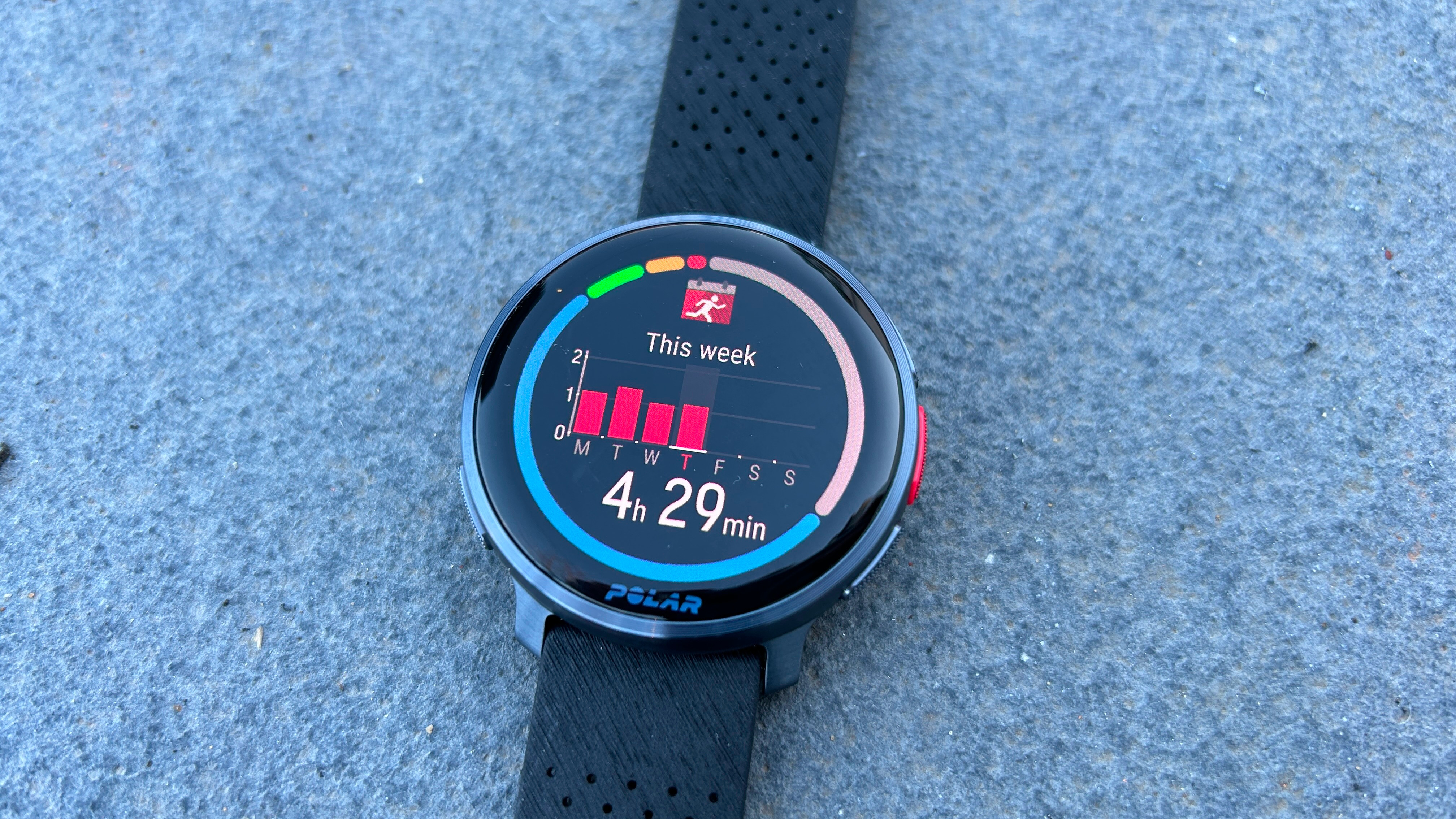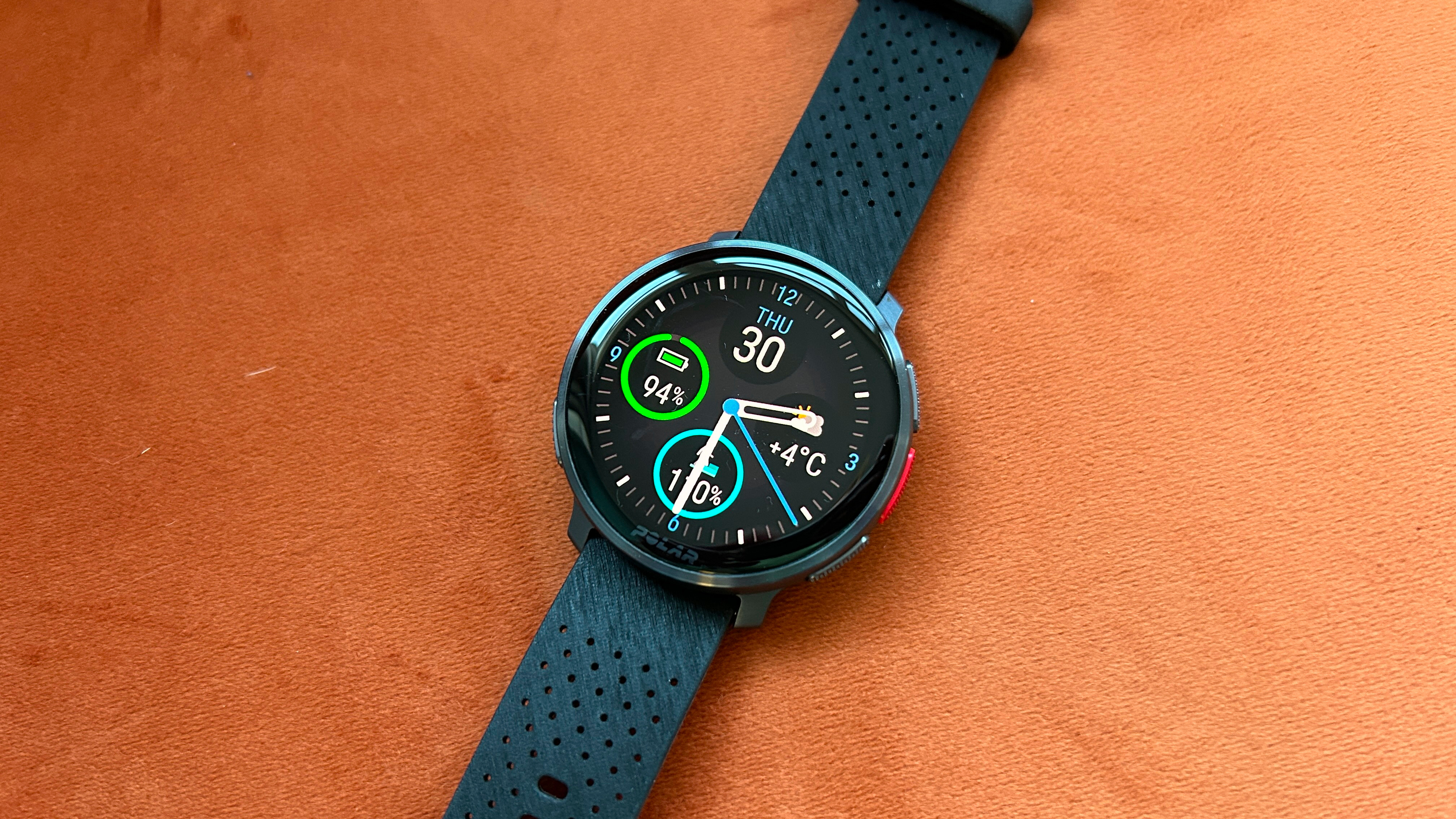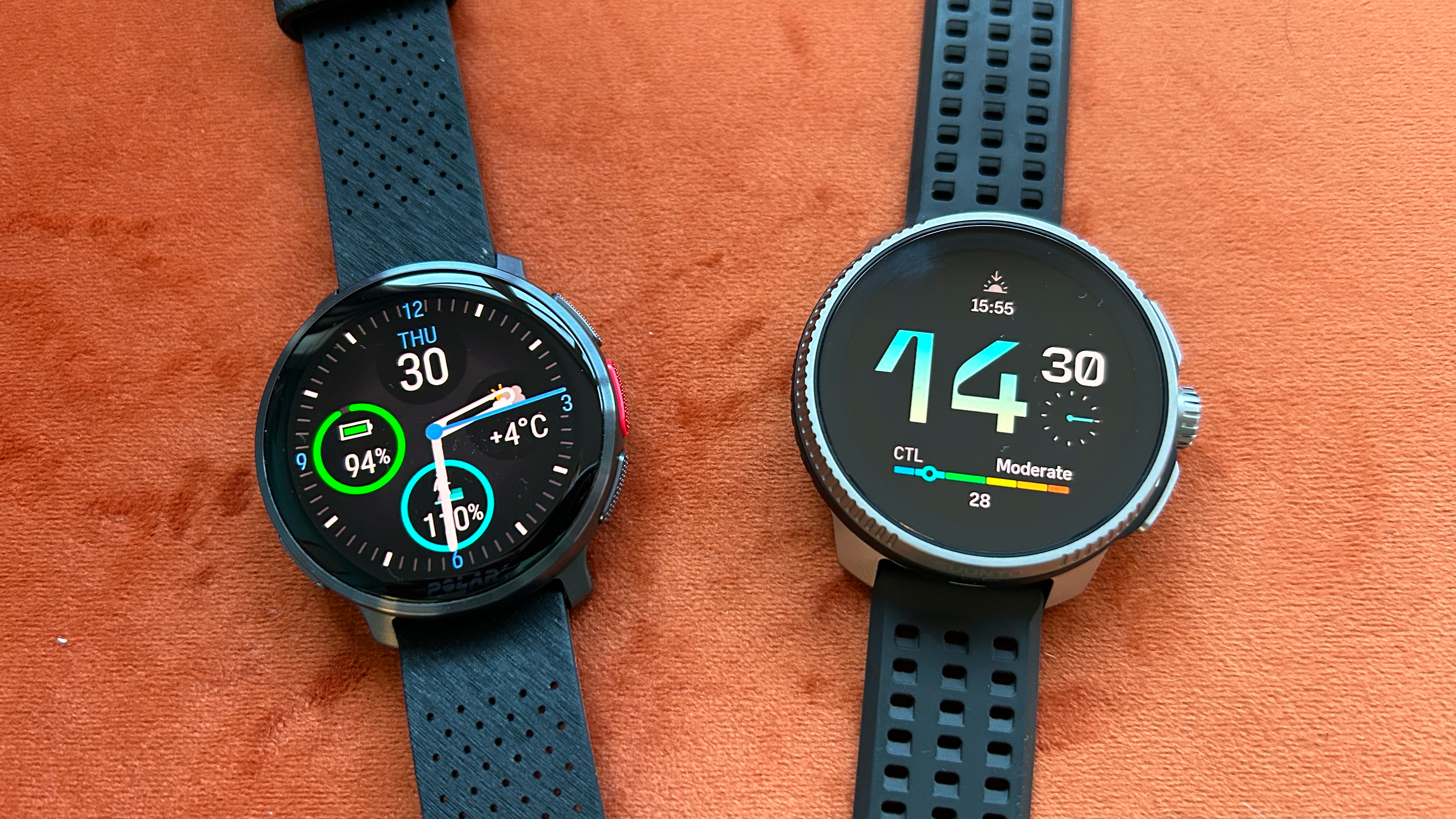Our Verdict
The Polar Vantage V3 is a big step up on what we’ve seen from the Finnish brand in the past, including new features and an attractive design with a bright AMOLED display. It’s an excellent watch, but at its price the Garmin Forerunner 965 still has the edge, while the outstanding Suunto Race is much cheaper.
For
- Great design and AMOLED screen
- Multi-band GPS
- Maps
Against
- Poor HR accuracy
- Limited smart features
- Short battery life
You can trust Coach
Even the best Polar watches have fallen short of the standards set by Garmin in recent years, and Coros’s watches have also caught up with and then overhauled Polar’s. So Polar needed to aim high with the Vantage V3. It has duly done that, making an AMOLED watch with features including maps and multi-band GPS.
The Polar Vantage V3 is one of the best sports watches and certainly the best Polar has made, though I wish the price wasn’t so high. For the money the Garmin Forerunner 965 is simply a better watch with more features, while the new Suunto Race is also an excellent AMOLED sports watch and is much cheaper (£100+ cheaper) than the Vantage V3.
Polar Vantage V3 Review: Price And Availability
The Polar Vantage V3 launched in October 2023 and costs $599.90 in the US and £519 in the UK. The price has risen compared with the Vantage V2, which cost $499.99/£449 at launch, which is justifiable considering the V3 is a major upgrade on the V2. However, what’s a concern is the fact the V3 is the same price as the Garmin Forerunner 965 in the US (though cheaper in the UK), and more expensive than the Suunto Race, which is $449/£389 for the steel version.
How I Tested This Sports Watch

I’ve been testing the Polar Vantage V3 for a month, during which time I used two watches because the screen on the first had a problem. During the month, I tested the Vantage V3 against other top sports watches including the Suunto Race and Garmin Epix Pro, and I’ve also tested most of Polar’s range in the past, including previous Vantage generations. Here’s my Polar Vantage V2 review and Polar Vantage review.
Design And Hardware
Garmin has shown with the Epix Pro, Forerunner 965 and Forerunner 265 watches that it’s possible to make brilliant sports watches with AMOLED displays without the battery life suffering too much, so it was inevitable other brands would follow suit.
Polar’s first AMOLED watch was the Ignite 3, but the Vantage V3 should be seen as its first proper sports watch with an AMOLED display—and it’s fantastic. The 1.39in touchscreen is bright and clear in all conditions, and responded quickly to touches and swipes during my testing. You can set the screen to always-on, although this just shows a basic analogue watch face rather than a dimmer version of your chosen watch face.
In general, the watch is attractive and lightweight, weighing 57g with the silicone band it comes with. It has an aluminum case and bezel that you can get in black or silver, and has five buttons for navigating features, if you prefer to use them instead of the touchscreen.
Sign up for workout ideas, training advice, reviews of the latest gear and more.
Polar has upgraded the GPS chip and heart rate sensor on the watch compared with the Vantage V2. The V3 has multi-band GPS, which should result in more accuracy (though it didn’t with the Polar Ignite 3’s multi-band), and has a new Gen 4 optical heart rate sensor, also aimed at increasing accuracy. Other new sensors allow the watch to take electrocardiogram (ECG) readings (though it’s not certified as a medical device) and measure your skin temperature and blood oxygen saturation.
The Vantage V3 is waterproof to 50m and has a barometric altimeter. You can pair external sensors to the watch using Bluetooth, but not ANT+.
Sports Tracking And Training Analysis

For all the watch’s new features, the sports tracking and training analysis remains the same as on the Vantage V2. While a few updates would have been welcomed—you can show only four stats on a data screen during activities and the structured workout builder is clumsy compared with those of Garmin, Suunto and Coros—it’s still an excellent multisport watch.
Most sports modes you could want are available, with the notable exception of a proper track run mode, which is available on Garmin, Coros and the Apple Watch and uses algorithms to log more accurate distance and pace when running on a 400m track. The Polar track mode just uses GPS, so it isn’t as accurate on a tight loop like a track.
Your data feeds into Polar’s detailed training and recovery analysis. You can use the sleep tracking on the watch to supplement your recovery advice through Nightly Recharge, or take orthostatic tests each day using the Recovery Pro feature. These tests used to require the use of a heart rate chest strap but can now be done on the watch using the ECG hardware. You can’t use Recovery Pro as well as Nightly Recharge to judge your recovery; the watch makes you choose. I prefer the automatic Nightly Recharge feature as opposed to making time to take the tests regularly.
It takes a few weeks for the training analysis to be useful, as the Vantage V3 needs time to get used to how much you train. There are graphs and details of your training load in the Polar Flow app, and there’s a widget on the watch giving basic information, plus more detail on the Polar Flow website. I’d prefer more info on the watch, but others will enjoy diving into their stats on a website.
GPS And HR Accuracy
The addition, in recent years, of multi-band GPS to sports watches has resulted in the most accurate trackers ever, but not all multi-band is created equal. Garmin and Suunto devices with multi-band are highly accurate. The Polar Ignite 3, however, was not.
Fortunately, Polar has fixed this with the Vantage V3, which is the most accurate Polar watch I’ve tested. Throughout my testing I compared it with the Garmin Epix Pro and Suunto Race and while I’d say the Polar made a few more errors than those watches—smoothing corners or veering of course more often—it’s still an accurate GPS tracker.
The heart rate accuracy wasn’t good for me, however. I saw significant errors on most runs, with readings both higher and lower than that on a chest strap. This skews the training analysis you get from the watch, and your activity tracking, so I eventually paired a Polar H10 to the Vantage V3 for improved accuracy.
Navigation
The Vantage V3 has color maps which you can use offline once you’ve loaded them onto the watch. To do this you need to download the areas of the world you want on the Polar Flow website and then drag and drop them on the watch. It’s complicated, but you won’t need to do it often and it’s faster than downloading them wirelessly because map files are large—the Vantage V3 has 32GB of storage to accommodate them.
Once they’re on the watch you can add maps to any activity that uses GPS, and you see a map screen among your data screens. Strangely, you don’t see a track of where you’ve been in an activity unless you have a route loaded. With any other brand that has maps, a trail is laid, which can be handy for retracing your steps; with Polar you just see a pointer to show where you are at that moment. Hopefully, this is something Polar will add to the watch in due course.
To add routes you need to get them into the Polar Flow app or website and then select them as a favorite you want to see on the watch. You can manually add any route created with a third-party app or website, but if you want turn-by-turn directions you need to use Komoot, which syncs routes automatically across to Polar.
I used several routes on the watch, with and without turn-by-turn directions, and it is easy to follow them with the maps on the bright AMOLED display. The watch also shows the elevation profile for your route, though it doesn’t have anything as smart as Garmin’s ClimbPro, which analyzes each climb and descent on your route and shows them individually when you’re tackling them so you can judge your effort accordingly.
Polar doesn’t have “routable” maps like Garmin, which allow you to create routes on the fly rather than just follow trails loaded over the map, but the new navigation features are still a plus point for the Vantage V3.

Activity And Sleep Tracking
The Vantage V3 tracks the usual daily activity stats like steps, active calories and floors climbed. However, it does steps in an unusual way—any activity adds steps. So bike rides and swims, or vigorous hand waving, will add to your step target, which means the totals you get from the Vantage V3 are higher than from other watches. The watch also breaks down your calories burned by your metabolism, your general activity and any training done that day.
There are three activity levels you can set as your general goal and these are designed to suit different lifestyles, with level 1 being for mostly sedentary people and level 3 for active people. The goals are based on active time and intensity, so to hit 100% of level 2, for example, requires nine hours and 19 minutes of low-intensity activity, two hours and 48 minutes of medium intensity, or one hour and 13 minutes at high intensity.
The watch’s sleep tracking is detailed and accurate as far as I can tell, but only when it actually logs a night of rest. My sleep is broken up at the moment owing to a rambunctious six-month-old and, on several occasions, I didn’t log enough continuous sleep to get my Nightly Recharge information from Polar.
If you have a more consistent bedtime schedule, Polar’s sleep tracking is useful in the detail it provides, and more accurate than what I’ve experienced with Garmin watches. You also get a Boost From Sleep graph for the next day that shows when you’re going to have the most energy. It’s a good idea and could be used to time training sessions, although if you’re sleeping well it looks similar each day, and when not sleeping well it’s just depressing to see you have no periods with significant boost from sleep, which I had a couple of times.
Overall, I think the Vantage V3 is a good sleep and activity tracker, though it’s a shame it doesn’t have any kind of “training readiness” stat, which I find useful on Garmin watches.
Smart Features
The Polar Vantage V3 offers notifications, has a weather forecast widget, and can control music playback on a linked phone, but it’s otherwise not a smart device. There’s no music storage or NFC payments and throughout my testing it struggled to stay linked to my phone reliably, which scuppers notifications. It looks great with its AMOLED display, but if you want smarts you’re better off with Garmin, or even Coros devices, let alone true smartwatches with app stores and cellular (phone connection) like the Apple Watch.
Battery Life
With any AMOLED watch the battery life is a concern, and I found when I enabled the always-on screen and used the Vantage V3 for runs every day it lasted only three or four days on a charge. With the always-on screen turned off outside of activities, it lasts a week, but still needs charging more often than the Forerunner 965 and Suunto Race with always-on enabled on those watches.
The GPS battery life is strong at more than 40 hours, even when using the most accurate multi-band mode. This matches well to rival watches, but it’s outside activities where the Vantage V3 seems to drain much faster than watches like the Race and 965—perhaps because the more detailed sleep tracking Polar offers requires more intense use of sensors overnight.
I’d say the battery life is good enough for an AMOLED watch that does as much as the Vantage V3 in terms of sports and general activity tracking, but you can get more juice from rivals.
Is The Polar Vantage V3 Worth It?

I really enjoyed using the Polar Vantage V3 and it’s a great sports watch, but it’s also a hard sell because there’s nothing here that I think Polar does significantly better than Garmin, or Suunto with the Race watch—and you get more features on top Garmins.
With the Vantage V3 the same price as the Garmin Forerunner 965 in the US that’s an easy choice. The Garmin is a better sports tracker in my experience, and has extra features like music storage, NFC payments and improved navigation, and lasts longer on a charge.

The Suunto Race is another strong alternative with an AMOLED screen that’s cheaper even if you opt for a titanium model with a sapphire screen, which will be more durable than the materials used on the Vantage V3. The Race has its own problems but has better battery life than the Polar and more impressive GPS accuracy, and Suunto has been smart in undercutting Garmin and Polar with its pricing.

Nick Harris-Fry is a journalist who has been covering health and fitness since 2015. Nick is an avid runner, covering 70-110km a week, which gives him ample opportunity to test a wide range of running shoes and running gear. He is also the chief tester for fitness trackers and running watches, treadmills and exercise bikes, and workout headphones.

